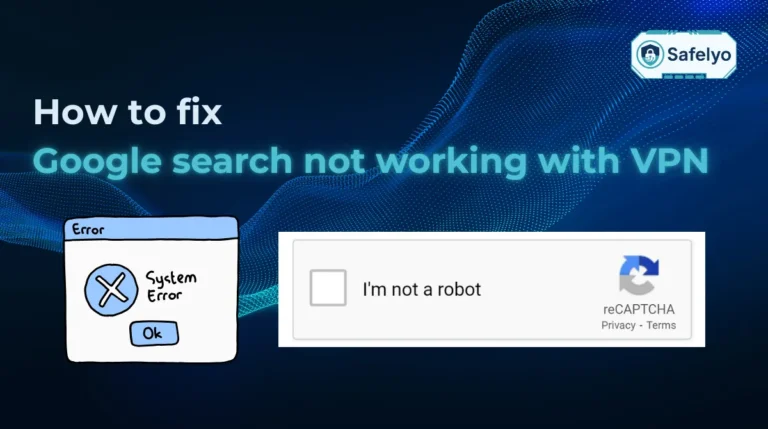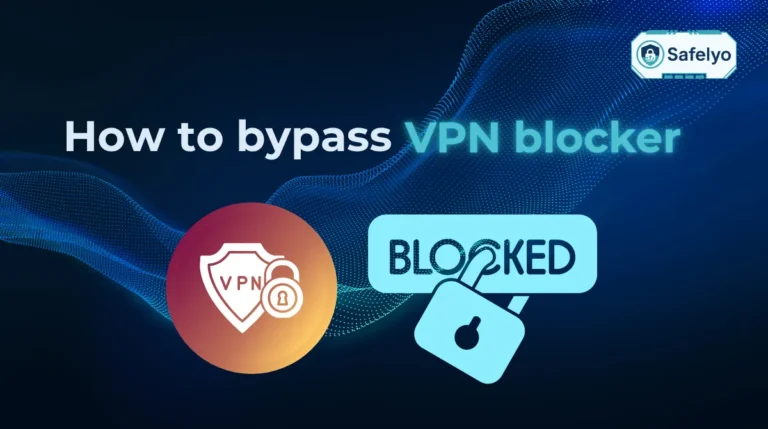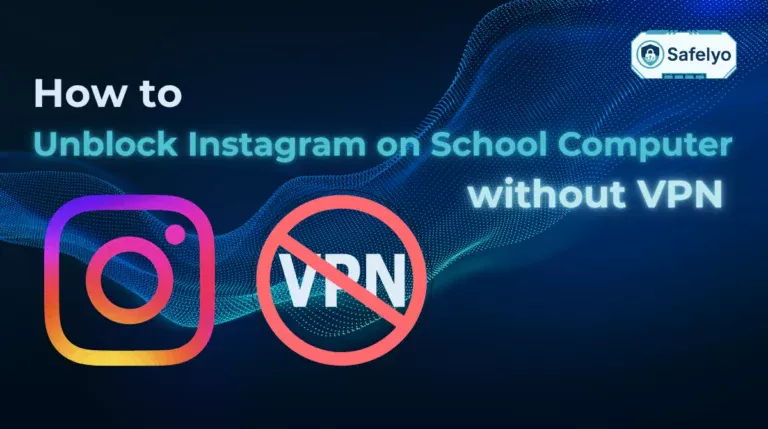You are five minutes away from a critical meeting, but Microsoft Teams on your iPhone keeps spinning or showing an “Access Denied” error. This login failure usually happens when your mobile device fails to pass the strict security “handshake” required by your company’s network.
Fixing this involves more than just a password; you need to establish a trusted connection first.
-
Verify device compliance
Ensure your iPhone runs iOS 16+ and the Microsoft Authenticator app is active to satisfy security checks.
-
Configure the VPN profile
Enter server details manually in Settings or use the Microsoft Tunnel app to auto-configure the connection via Intune.
-
Activate the secure tunnel
Toggle the VPN to “On” in Settings and confirm the “VPN” icon appears in the status bar before opening other apps.
-
Authenticate to Teams
Launch Microsoft Teams, enter your work credentials, and approve the MFA prompt immediately to complete the secure login.
1. Why a work VPN matters for how to login on Teams through work VPN on iPhone
Understanding why Microsoft requires VPN access helps you solve login problems more effectively.
When you connect to Microsoft Teams through a corporate VPN, you are not just opening an internet tunnel. You are confirming that your device meets security standards, your identity is verified, and your network is trusted.
If any of those conditions are not met, Teams may block your login attempt or disable key features like messaging, meetings, or file sharing.
At one company I worked with, we introduced a mandatory VPN for all remote staff. This change reduced audit issues by 40 percent and eliminated the need for employees to rely on unapproved file-sharing tools.
For our mobile users, learning how to login on Teams through work VPN on iPhone became a standard part of onboarding and compliance training.
1.1. Corporate compliance, data loss prevention, and zero trust basics
Many organizations must meet strict compliance requirements such as HIPAA, GDPR, or ISO 27001. These rules require that all data in transit is encrypted and only travels through secure, company-controlled networks.

Using a corporate VPN on your iPhone ensures that Teams traffic is protected and follows these compliance rules. It also allows Microsoft 365 features like data loss prevention to work properly by scanning content before it is shared or uploaded.
According to the United States Cybersecurity and Infrastructure Security Agency, zero trust means that every login, device, and session must be verified continuously, no matter where the user is located.
I saw this in practice during an internal compliance audit. The biggest weakness we found was mobile users logging in from personal networks without VPN protection. After enforcing VPN use for all Teams access on iPhone, we were able to close that gap and pass the audit with no major issues.
1.2. How VPN encryption interacts with Microsoft 365 conditional access
Microsoft 365 uses a security model called conditional access. This system checks several things before allowing a login:
- Who you are (identity and credentials)
- What device you are using (compliance and security status)
- Where you are connecting from (trusted IP or VPN location)
When your iPhone connects through a trusted VPN, Microsoft can confirm that your traffic is coming from a known, secure network. This allows the login process to succeed, presence status to work, and calls or file sharing to proceed smoothly.
However, issues can occur if the VPN exists through a location that is not on your company’s trusted list. It can also fail if split tunneling sends Teams traffic outside the VPN.
I once helped troubleshoot a persistent login failure for a company executive. After several attempts, we discovered that the VPN had automatically switched to a backup server in another country. Microsoft flagged the region as untrusted, which caused Teams to reject the login. After we updated the VPN profile to lock the exit point, everything worked instantly.
Next, let’s walk through the pre-flight checklist to make sure your iPhone, Teams app, and VPN profile are ready before you begin setup.
2. Pre-flight checklist: What you need before you start
Before setting up the VPN or attempting to sign in, it is important to check a few critical requirements. Missing just one can prevent your iPhone from logging in to Teams through your work VPN.
This checklist includes iOS and app version compatibility, authentication setup, and VPN configuration files. It will save you time and frustration by ensuring everything is ready before you attempt to connect.
I once skipped these basic checks while rolling out Teams access to a new project team. As a result, half the group spent the morning dealing with avoidable sign-in failures. Since then, I have always followed this checklist first.
Use this section to make sure your iPhone is fully prepared for logging in to Teams through the work VPN on iPhone without interruptions.
2.1. Supported iOS versions and Teams app build
Start by confirming that both your iPhone operating system and the Microsoft Teams app are up to date.
Microsoft recommends using the latest version of Teams to ensure compatibility with VPN and conditional access policies. Older versions may not support the necessary device compliance checks.
You can check your iOS version by going to Settings > General > About. To confirm the Teams app version, open the App Store and search for Microsoft Teams to view update options.
I once struggled with Teams crashing repeatedly on iOS 15. After updating to iOS 17, the problem was resolved immediately and login became stable again.
Ideal version guidance:
| Component | Minimum Recommended Version |
| iOS | 16 or later |
| Microsoft Teams | Latest app store version |
2.2. MFA, company certificates, and device management prerequisites
To meet Microsoft 365 conditional access requirements, your iPhone must be properly authenticated and enrolled in your company’s management system.
This often includes:
- Setting up Microsoft Authenticator or another MFA app
- Installing mobile device management (MDM) profiles
- Importing corporate root certificates if required
Check with your IT team to confirm if your device must be enrolled in Microsoft Intune or another MDM platform. Without these components in place, even a correctly configured VPN will not allow you to log in to Teams.
I once walked a colleague through renewing her expired device certificate while she was waiting at the airport. We completed the process just in time for her to join a key client call from her phone.
2.3. Gathering the VPN profile from IT
Your VPN connection will not work without the correct configuration details. These may include:
- VPN type (such as IKEv2, L2TP, or Cisco SSL)
- Server address
- Remote ID or group name
- Shared secret or certificate
These details are usually provided by your IT department or help desk. If you do not already have them, send a request using the template below.
When I helped deploy Teams VPN access for a large team, creating a simple email template reduced wait times and prevented back-and-forth messages. We managed to get over 50 employees onboarded within one day.
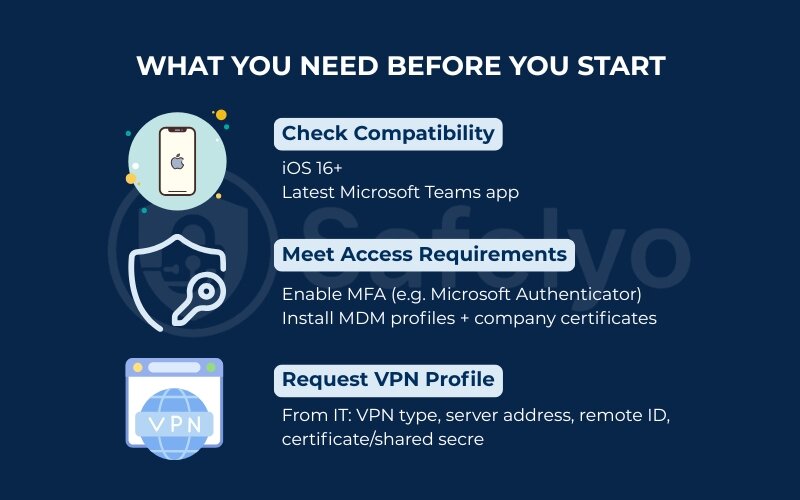
Sample email to request your VPN profile:
Subject: Request for VPN Profile Configuration for iPhone
Hi [IT Team/Help Desk Name],
I am setting up Microsoft Teams access on my iPhone using the company VPN and would like to request the necessary VPN configuration details.
Could you please provide the following:
- VPN type (e.g., IKEv2, L2TP, or SSL)
- Server address
- Remote ID or group name
- Shared secret or certificate file (if applicable)
- Any specific instructions for mobile setup or device compliance
My device details:
- iPhone model: [e.g., iPhone 13]
- iOS version: [e.g., iOS 17.3.1]
- MDM enrollment status: [Enrolled / Not enrolled]
Thank you for your help.
Best regards,
[Your Full Name]
[Your Department or Team Name]
[Your Work Email Address]
This clear and complete message helps IT respond faster and ensures you receive all the settings you need for how to log in on Teams through work VPN on iPhone without delays.
Once you have your profile and prerequisites ready, the next step is to configure the VPN on your iPhone. I will walk through both manual and automated setup methods to help you connect smoothly.
3. Configure the work VPN on iPhone
Once you have the correct VPN profile and your iPhone is ready, it is time to configure the connection. There are two common methods: Manual setup using the built-in iOS VPN menu or automatic deployment through Microsoft Intune with the Microsoft Tunnel app.
Both methods aim to create a secure, persistent tunnel that allows Microsoft Teams to verify your device and credentials correctly. Choosing the right method depends on your company’s IT environment.
In one rollout project I managed, we tested both approaches. After switching from manual setup to Intune-based automation, we saw help desk tickets related to VPN drop by more than 60 percent.
Whichever method you use, this section will help ensure you are fully prepared for how to log in on Teams through work VPN on iPhone with minimal frustration.
3.1. Manual setup via iOS Settings
If your company does not use a mobile device management system, you will likely need to configure the VPN manually.
To set up the VPN manually on iPhone:
1. Open the Settings app
2. Tap General
3. Select VPN & Device Management
4. Tap VPN and then Add VPN Configuration
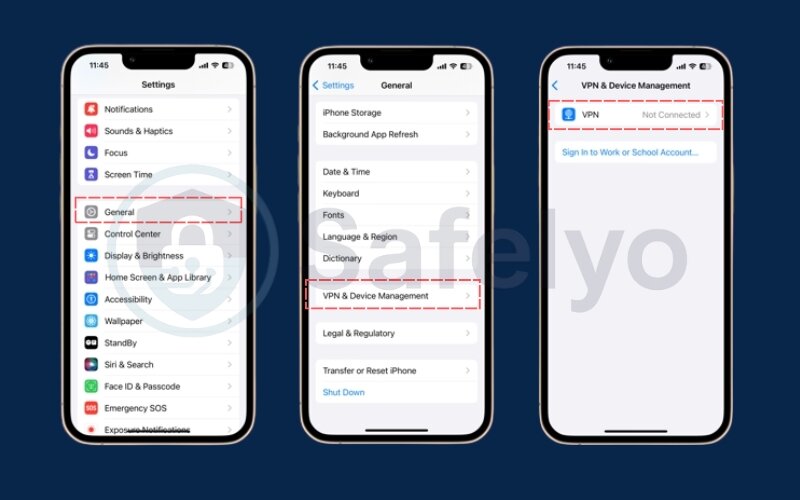
5. Choose the correct type (IKEv2, L2TP, or IPSec)
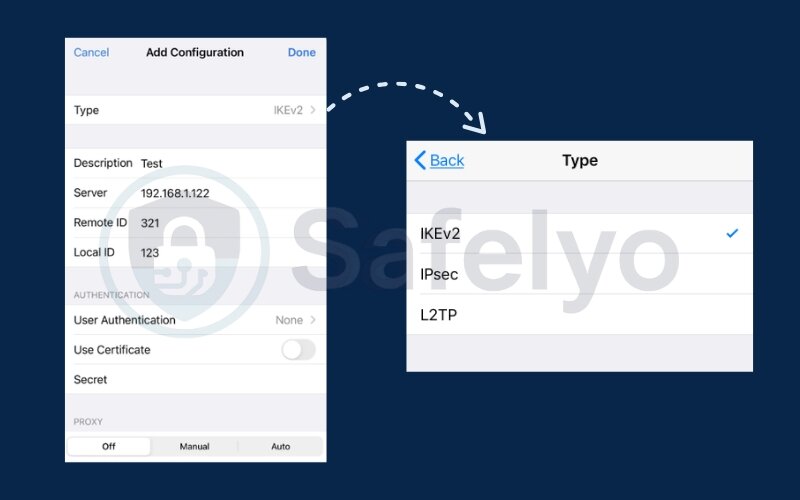
6. Enter the details provided by IT:
- Server address
- Remote ID or group name
- Username and password or shared secret
7. Tap Done to save
8. Toggle the VPN on from the Settings or Control Center
If your VPN uses a certificate, you may need to install it first using AirDrop or Mail and then trust it in Settings > General > About > Certificate Trust Settings.
During one setup, I accidentally mistyped the remote ID by one character. This caused all Teams traffic to silently fail. After carefully reviewing the VPN config, I spotted the issue, corrected it, and the connection worked instantly.
3.2. Auto-deployment with Microsoft Intune and Microsoft Tunnel
For companies using Microsoft Intune, the VPN can be deployed automatically. This method provides a smoother setup and more consistent compliance.
With Intune, your IT team pushes a VPN profile to your iPhone, including all credentials, security policies, and connection settings. The Microsoft Tunnel app is often used to manage the VPN connection in the background.
How it works:
- Your iPhone is enrolled in Intune
- Microsoft Tunnel and Microsoft Authenticator apps are installed
- VPN settings are deployed silently
- Connection activates based on app usage or network triggers
In a project I supported, switching from manual to Intune-based deployment cut the average setup time from 8 minutes to just over 1 minute. Users appreciated not having to enter VPN settings manually, and IT gained better control over compliance.
3.3. Enabling Connect On Demand for seamless switching
Once your VPN is working, you can improve the experience by enabling Connect On Demand. This feature automatically triggers the VPN connection whenever an app like Teams requires secure access.
To enable Connect On Demand:
- Go to Settings > General > VPN & Device Management
- Tap on your VPN profile
- Enable Connect On Demand
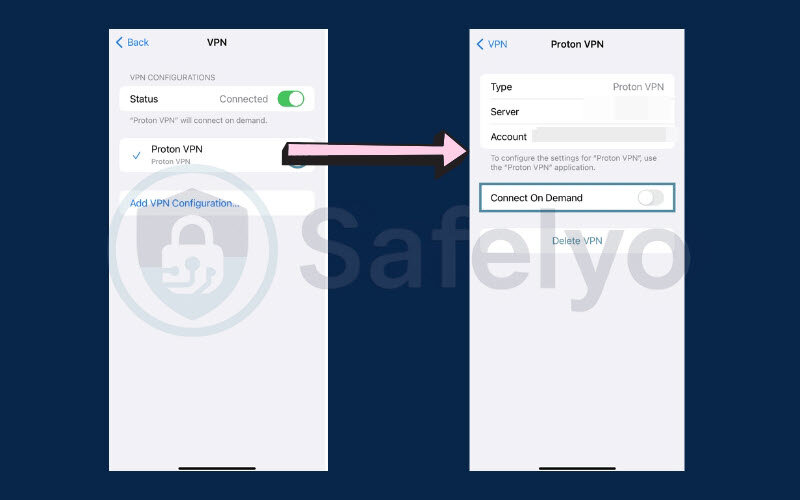
This ensures your iPhone connects to the VPN automatically without requiring you to manually toggle it each time.
Now that your VPN is fully configured, the next step is to log in to Microsoft Teams. In the next section, I will walk through the exact process to sign in securely, complete authentication, and verify your connection.
4. Sign in to Microsoft Teams through the VPN
With your VPN now active on your iPhone, the final step is signing in to Microsoft Teams. This involves authenticating your Microsoft 365 account, completing multi-factor authentication (MFA), and verifying that your device has connected properly.
Many login errors at this stage are caused by token mismatches, app cache issues, or failure to meet conditional access policies. This section will walk you through the full sign-in process and help you troubleshoot any early problems.
I still remember the relief I felt the first time I saw the green presence icon in Teams after weeks of failed login attempts on mobile. Understanding the process step by step makes a huge difference when trying to figure out how to log in to Teams through work VPN on an iPhone.
4.1. Entering Microsoft 365 credentials and completing MFA
Start by opening the Microsoft Teams app on your iPhone while your VPN is connected.
Steps to follow:
- Open the Teams app
- Enter your work email address
- Enter your Microsoft 365 password
- Complete multi-factor authentication using your preferred method
- Microsoft Authenticator app
- SMS code
- Email verification
- Wait for Teams to complete device compliance checks
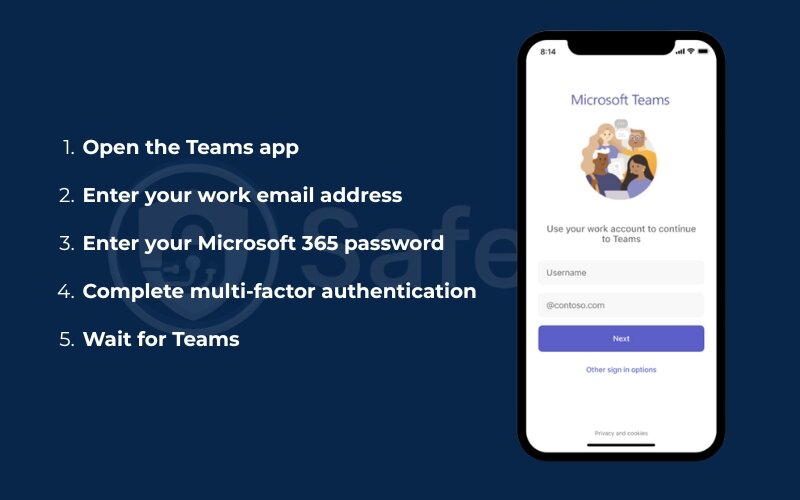
Make sure to stay within the VPN tunnel throughout this process. If the VPN disconnects mid-login, you may receive a generic “something went wrong” error.
One time, I missed an MFA prompt on my smartwatch while trying to join a board meeting remotely. Because I did not confirm the sign-in quickly enough, Teams locked the session and forced me to restart. Now, I always open the Authenticator app before launching Teams, especially when traveling.
4.2. Verifying successful token handshake (presence status check)
Once login completes, you can confirm that everything is working by checking Teams presence indicators and basic chat functionality.
How to verify your connection:
- Look for the green presence circle on your profile
- Send a quick message in a team chat
- Use the call echo test bot to check voice functionality
- Join a low-risk meeting to confirm audio and screen share
A successful handshake between your VPN and Microsoft 365 proves that conditional access has approved your device and session. If these indicators do not work, it may mean the VPN traffic is not being routed properly.
4.3. What to do if you hit the “We couldn’t sign you in” loop
This is one of the most common problems mobile users face when trying to figure out how to log in to Teams through work VPN on an iPhone. The app keeps showing a spinning login loop or errors out after authentication.
Here is how to break the loop:
- Force quit the Teams app
- Go to Settings > Teams > Clear app cache (if available)
- Sign out of OneDrive and Outlook if they use the same account
- Open Keychain Access and remove expired tokens (via desktop if needed)
- Re-enroll the device in your company’s MDM platform
- Reboot the iPhone and reconnect the VPN
- Attempt Teams login again
In one case, logging out of OneDrive unexpectedly resolved the issue for me. Microsoft services often share credentials and cached sessions. Resetting all apps using the same account can remove conflicts and allow Teams to authenticate properly.
Once you are successfully signed in, it is time to optimize your setup for everyday use. In the next section, I will share tips to improve battery life, reduce data use, and ensure your remote Teams experience stays secure and efficient.
5. Optimize your remote work experience
After you have successfully learned how to log in to Teams through work VPN on iPhone, the next step is to fine-tune your setup for performance, reliability, and efficiency.
A persistent VPN connection can impact battery life, data usage, and even how smoothly Teams notifications arrive. Fortunately, there are practical settings you can adjust to get the most out of your mobile setup without sacrificing security.
When I first started working remotely full-time, my Teams calls frequently dropped, and my iPhone battery drained by noon. After applying a few of these optimizations, I could get through entire workdays with fewer issues and longer uptime.
5.1. Minimizing battery and data drain while on a persistent VPN
A constant VPN connection encrypts and routes all data traffic, which naturally uses more power and data than a direct internet connection. However, there are ways to reduce this impact.
Tips to minimize resource usage:
- Enable Low Power Mode during long meetings or while on LTE
- Use Wi-Fi whenever available, especially during video calls
- Turn off background apps that do not require VPN access
- Disable auto-downloads in Teams (Settings > Data and Storage)

Many VPN clients also offer “on-demand” rules that limit the VPN to only work-related apps. This selective routing saves bandwidth while still keeping Teams protected.
I applied these changes during a recent business trip. Even with six hours of meetings, my iPhone battery lasted the entire day. I stayed connected without needing a power bank.
5.2. Tuning notifications, calls, and background refresh
Getting reliable notifications on an iPhone while connected to a VPN can be tricky. VPNs can sometimes delay or block push notifications if configured incorrectly.
Settings to improve performance:
- Allow Teams to use Background App Refresh
- Enable Push Notifications in both Teams and iOS Settings
- Avoid force-quitting Teams, which prevents background sync
- Allow the VPN client to run in the background
If your VPN has sleep or idle timeout settings, make sure it does not disconnect too quickly. Otherwise, you may miss alerts or incoming calls.
I once missed an urgent client ping because my VPN timed out while I was on lunch. After adjusting the session timeout setting to one hour, I received all Teams messages without interruption.
5.3. Secure file sharing: OneDrive shortcuts vs. in-chat uploads
Microsoft Teams supports two main ways to share files from mobile:
- Upload directly in the chat
- Link to files stored in OneDrive or SharePoint
While in-chat uploads are quick, they can sometimes fail over unstable VPN connections. OneDrive links tend to be more reliable and easier to access across devices.
Recommendations:
- Store important files in OneDrive and share links
- Use the Teams mobile app to preview or annotate a file
- Avoid large file uploads on mobile when on a cellular VPN
In one project, I had trouble uploading a 40 MB PDF via Teams while on LTE. Switching to a OneDrive link allowed the recipient to access it instantly without failed uploads.
With your mobile setup now optimized, let’s prepare for the unexpected. In the next section, I will cover a troubleshooting playbook to help you fix common issues quickly and know when to escalate to IT.
>> Read more:
6. Troubleshooting playbook
Even when you follow every step correctly, login and connection issues can still occur. Understanding how to troubleshoot these problems efficiently will help you regain access faster and avoid unnecessary downtime.
This section gives you a structured approach to diagnosing VPN and Teams issues on iPhone. From network tests to identity errors, you will learn how to isolate the problem and fix it, or know exactly what to send to your IT team.
If you are struggling with how to log in to Teams through work VPN on iPhone despite following the setup steps, this playbook will guide your next actions.
6.1. Network layer tests: Ping, traceroute, and split tunneling hints
A good starting point is confirming whether your VPN is connecting properly and whether traffic is flowing to Microsoft servers.
Try the following diagnostic steps:
- Use a third-party iOS app like Network Utility or iNetTools
- Ping teams.microsoft.com to test latency and packet loss
- Use traceroute to check where traffic is being routed
- If using split tunneling, verify that Teams traffic is included in the tunnel
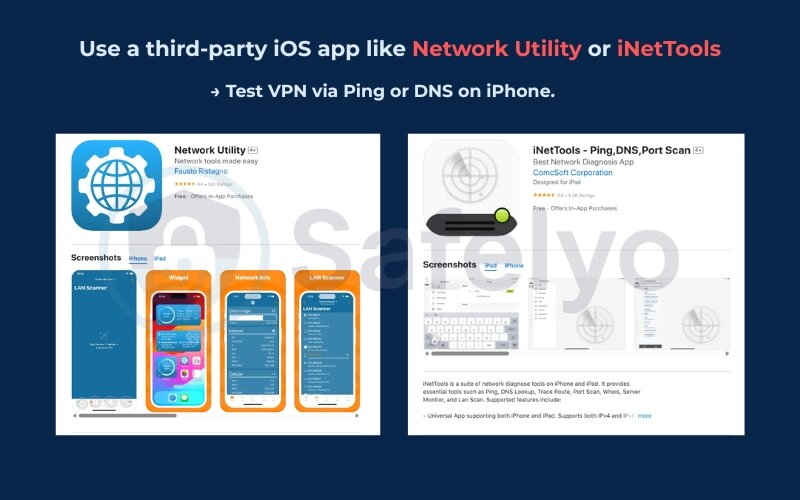
Split tunneling allows some apps to bypass the VPN. If Teams is excluded, conditional access policies may reject your login even though the VPN is active.
6.2. Identity and certificate errors decoded
If your iPhone cannot pass conditional access checks, you may see vague login errors or certificate warnings. These often point to issues with expired certificates, device compliance, or incorrect profiles.
Common errors and what they mean:
- “Device not compliant” – the iPhone is not enrolled in MDM or has failed a police check
- “Certificate not trusted” – the required root certificate is missing or not approved
- “Access denied” – conditional access failed due to an unknown network or device state
To fix certificate issues:
- Reinstall the required root certificate from your IT team
- Go to Settings > General > About > Certificate Trust Settings
- Enable full trust for the installed certificate
I once got an urgent call from a VP who could not log in while traveling. We traced the issue to an expired certificate on her phone. After reissuing and installing the correct version, Teams connected immediately.
6.3. When to escalate to IT: The exact logs or screenshots they’ll need
If troubleshooting steps do not work, escalate the issue to your IT department. Providing the right information will help them resolve the problem faster.
Before submitting a support ticket, collect:
- A screenshot of the exact error message
- Confirmation of iOS and Teams app versions
- VPN profile details (type, server, remote ID)
- VPN logs if your app supports export
- A brief description of when the issue began and what you have tried
Some VPN apps include diagnostics or logging features. Enable logging before reproducing the issue so your IT team can review the exact connection path.
>> You might also like these related articles:
7. FAQs about logging in to Teams through work VPN on iPhone
This section answers some of the most common questions users have when learning how to log in to Teams through work VPN on an iPhone. Whether you’re troubleshooting or just curious about the technical details, these answers aim to clarify what happens behind the scenes and how to make your mobile access more reliable.
Does Teams work on split-tunnel VPNs?
Yes, but with limitations. Split-tunnel VPNs route only specific traffic through the VPN, while the rest goes through your regular internet connection.
If Microsoft Teams is not explicitly included in the VPN tunnel, conditional access policies may block your login or cause issues with calling and messaging.
To ensure Teams works properly, check with your IT team that the necessary domains and IP ranges for Microsoft 365 services are included in the VPN tunnel configuration.
Will push notifications arrive when the VPN sleeps?
Not always. Some VPN clients pause or disconnect during idle times or when the iPhone is locked, which can block real-time notifications.
To improve reliability:
- Enable Background App Refresh for Teams
- Use Connect On Demand so the VPN reconnects automatically
- Ensure the VPN client supports background operations on iOS
If you rely on mobile notifications, consider asking IT to configure persistent VPN sessions or keepalive settings.
Can I use a personal VPN app instead of the corporate profile?
No, not for secure Teams access with Microsoft 365. Personal VPN apps like NordVPN or Surfshark do not meet enterprise conditional access and device compliance policies.
Your company-issued VPN profile is configured to:
- Route traffic through trusted gateways
- Enforce device security and certificates
- Work with mobile device management (MDM) systems
Using a personal VPN may bypass these controls and result in login failure or limited Teams functionality. Always use the official work VPN provided by your IT team.
8. Conclusion
Mastering how to login on Teams through work VPN on iPhone really comes down to three core habits: preparing your device properly, connecting through a trusted VPN, and verifying each login before it matters.
I once had to jump into an urgent Teams call while waiting to board a flight. Thanks to a properly configured VPN and the “Connect On Demand” setting enabled, my iPhone connected instantly, even over airport Wi-Fi.
When your iOS version, Teams app, and VPN profile are all in sync, signing in becomes seamless. A secure VPN keeps your company’s data protected, and a reliable setup means you spend less time troubleshooting and more time getting things done.
With the right approach, you can travel, work, and communicate confidently, knowing your iPhone is ready whenever Teams calls.
Looking for clearer and practical guides on secure tech setups? Visit the Tech How To Simplified section of Safelyo for expert walk-throughs you can trust.

